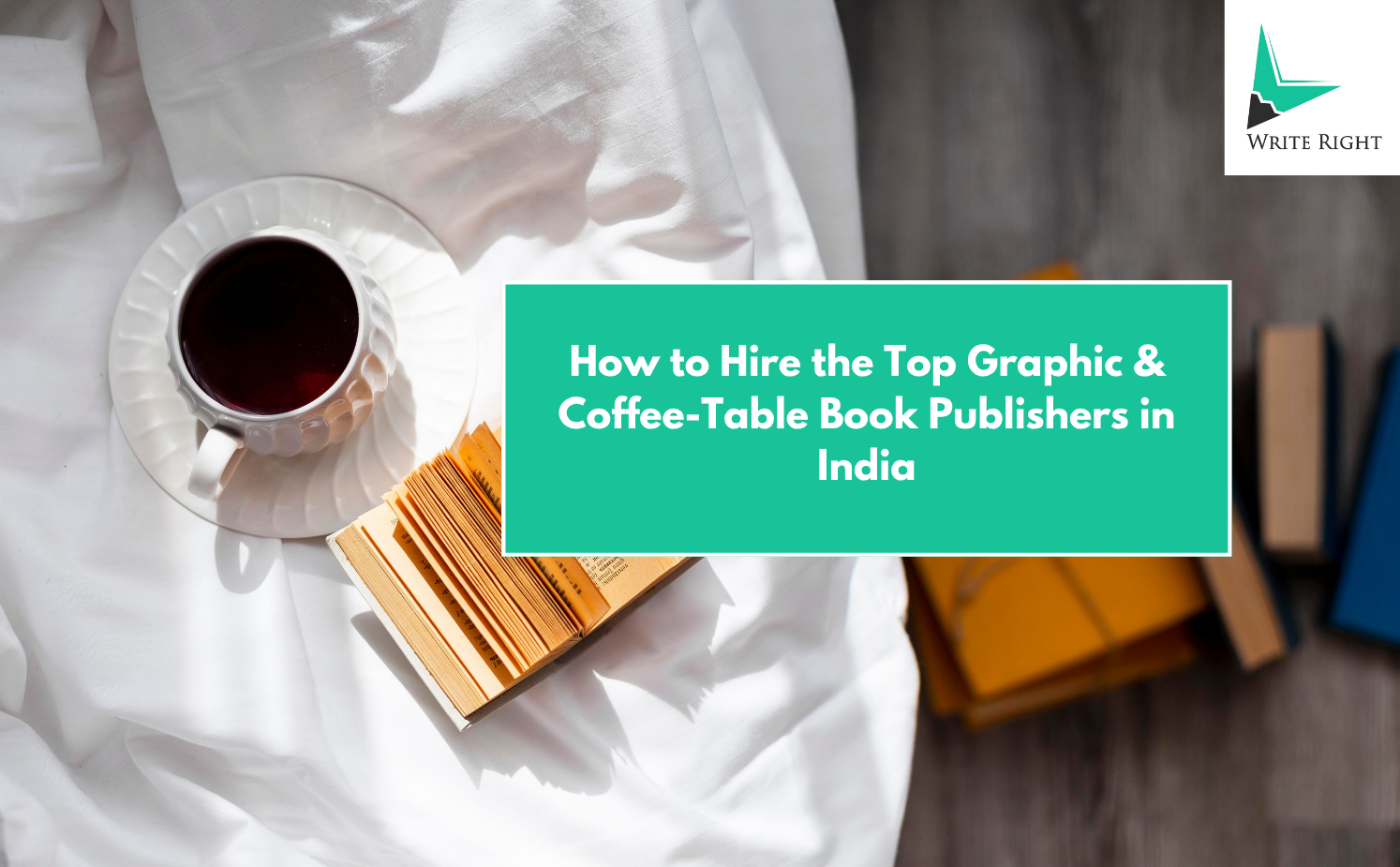Coffee-table books require precision in design, printing, and presentation. Publishers must manage color accuracy, image licensing, and durable binding while ensuring visibility in galleries, museums, and bookstores. Leading graphic and coffee-table book publishers in India, like Estorytellers and Write Right, provide end-to-end support—from submission guidance to verified distribution. By focusing on production quality, legal clearance, and real-world placement, authors can ensure their large-format, visually rich books make a lasting impact.
This guide also focuses on India and shows how to select a publisher that ensures production excellence while minimizing legal and logistical risks. You will also learn how to prepare a submission pack that meets editorial and production standards for large-format books.
TL;DR: How to Use This Guide
Decide book format and size, confirm the publisher’s ICC/spot color workflow, secure image and property rights, plan art budgets with revision caps, verify binding for heavy spreads, check museum or design-store distribution proof, and submit a production-ready package.
Facts You Can Use:
- Hard proof verification ensures accurate color reproduction.
- Layflat or Smyth-sewn binding supports heavy spreads.
- Model and property releases are mandatory for identifiable subjects.
- Spot UV or varnish finishes require plate planning.
- Carton and corner protection reduce shipment damage.
India’s Top Coffee-Table Book Publishers
Write Right delivers premium publishing services for graphic and coffee-table books, ensuring your visuals and stories shine.
What Counts as a Credible Graphic/Coffee-Table Publisher
Credibility is built on verified catalogs, production readiness, binding options for large-format books, and real-world placement in museum or design stores.
Catalog Strength
Publishers should maintain updated lists of art books across photography, architecture, fashion, and graphic design. Look for recent exhibitions, awards, or curated catalogs as proof of editorial expertise.
Production Readiness
Check if the publisher has ICC color pipelines, spot color planning, varnish/foil finishing, and sufficient plate counts for large-format projects.
Placement Evidence
Verified placements in museums, galleries, and design stores are critical. Online-only listings or promotional claims without proof should be treated cautiously.
Case Study:
A small architectural photography publisher with only 25 titles secured 15 museum placements in 2024, outperforming a generalist publisher with 60 titles due to quality proofs and verified distribution.
[Here’s How We Made it Happen]
Image Rights & Clearances
Obtain permissions for identifiable people, property, and third-party artworks. Maintain a detailed rights log with attached release letters.
Model & Property Releases
Signed permission is required for identifiable individuals, private interiors, or restricted landmarks.
Third-Party Content
Ensure clearance for archival photographs, maps, and brand marks. Track provenance and include proper credits in captions.
Clearances Table:
| Content Type | Permission Required | Notes |
| Model / Portrait | Yes | Signed release mandatory |
| Property / Interiors | Yes | Museum or private owner approval |
| Artwork / Archival | Yes | Include copyright & provenance |
Rights-Counsel Note: Keep all signed PDFs and maintain a rights log.
Professional Graphic Book Publishing
Write Right helps authors produce visually stunning coffee-table books with expert editing, design, and print services in India.
Color Management & Proofing
Deliver ICC-profiled images, request hard proofs, and define spot/Pantone colors and varnishes in advance.
ICC Profiles & Device Linking
Avoid double conversions and ensure device-link accuracy to preserve color fidelity across the workflow.
Hard Proof vs Soft Proof
Soft proofs are digital approximations; hard proofs under press conditions with marked tolerances are essential for color accuracy.
Spot Colors & Varnishes
Plan for plate counts, make-ready time, and approval processes to avoid production delays.
Mini Table:
| Stage | Deliverable | Responsible Party | Notes |
| Pre-Press | Hard Proof | Publisher | Must approve before press |
| Spot Colours | Plate Plan | Publisher & Designer | Confirm coverage & tolerances |
Quote: Production lead at Write Right: “Color tolerances must be approved on hard proof to avoid surprises on press.”
Large-Format Layout & Materials
Select paper, binding, and finishes that support heavy spreads and preserve image integrity.
Paper & Coating
Choose 200 to 300 GSM coated or matte stock with high opacity to prevent show-through and fingerprints.
Binding Options
Smyth-sewn, lay-flat, or case-bound bindings ensure durability and a flat opening. Avoid weak adhesives for heavy spreads.
Finishes
Include lamination, embossing, foil, or spot UV finishes in advance to prevent delays.
Case Study:
Switching to higher-opacity stock improved dark image reproduction and reduced bleed-through.
Table:
| Material | Specification | Purpose |
| Paper | 200 to 300 GSM, matte coated | Reduces show-through, fingerprints |
| Binding | Layflat / Smyth-sewn | Durability & flat spreads |
| Finish | Spot UV / Foil / Laminate | Image enhancement & protection |
Showcase Your Visual Stories
Write Right provides end-to-end publishing for coffee-table books, ensuring perfect print quality and elegant layouts.
Photography/Illustration Budgets
Set per-image, per-spread, or daily rates with caps on revisions and kill fees.
Scope Lines
Define retouch rounds, art direction responsibilities, and revisions clearly to avoid scope creep.
Credits & Captions
Ensure all images have provenance and rights credits properly formatted.
Budget Table:
| Deliverable | Responsibility | Payable When |
| Photo Shoot | Author / Photographer | Upon completion |
| Retouch | Illustrator | After approval |
| Kill Fee | Publisher | If image removed |
Heavy-Book Logistics
Use reinforced cartons, corner guards, shrink/foam wraps, and insurance for heavy books.
Carton & Edge Protection
Specify ECT/Burst rating and include desiccants for humidity control.
Palletization & Courier Selection
Plan shipments for minimal damage. Establish SOPs for claims and returns.
Case Study:
Damage rates dropped by 70% after adding corner guards and shrink wraps for 1000-copy shipments.
Bring Your Coffee-Table Book to Life
Estorytellers offers professional editing, design, and publishing services for graphic-heavy books across India.
Where Design Books Actually Sell
Museum shops, galleries, and design boutiques outperform online-only sales.
Vendor Onboarding
Set up accounts with museum shops and consignment stores. Track inventory and placements.
ISBN Metadata
Align metadata with exhibition tie-ins and catalog listings to improve discoverability.
Evidence Checklist: Supplier codes, catalog screenshots, and blurred placement photos.
Author Testimonial: Museum-shop tie-in led to 40% higher first-month sales than the online launch.
Marketing That Works
Exhibition tie-ins, design media, and launch events outperform broad PR campaigns.
Exhibition Alignment
Schedule launches around gallery openings or exhibitions for maximum visibility.
Media & Event Kits
Engage design magazines, blogs, and curated event kits, including press sheets, proofs, and image permissions.
Curator Quote: “Books aligned to exhibition schedules sell faster than generic online launches.”
Red Flags in Art/Design Publishing
Avoid publishers without hard-proof verification, broad rights grabs, weak binding, or unverifiable placement.
Rights Landmines
Watch for exclusive images or derivative rights without clarity.
Production Shortcuts
Soft proofs only or low-tolerance presswork are warning signs.
Distribution Puffery
Claims of museum or gallery placements without evidence should be questioned.
Conclusion
Publishing a large-format design or coffee-table book in India requires careful attention to production, rights, and distribution. Securing color-accurate proofs, layflat or smyth-sewn binding, verified image releases, and museum/gallery placement ensures durability and visibility. Write Right provides expert guidance, managing submissions, logistics, and legal clearances, reducing delays and risks.
Following this structured approach guarantees a professional launch, protects your creative work, and maximizes reach to collectors, institutions, and art enthusiasts.
Related Reads:
Top Poetry Book Publishers in Canada 2025: Chapbooks, Full-Length & Submission Essentials
Professional Coffee-Table Book Publishing
Write Right offers end-to-end services for graphic and coffee-table books, ensuring your work meets top publishing standards.
FAQs
Which Indian publishers handle color-critical coffee-table books well?
Publishers with ICC color workflows, hard-proof verification, layflat or smyth-sewn binding, and verified museum/gallery placements handle color-critical projects effectively. Boutique presses often outperform larger generalist houses due to precise production pipelines. Write Right ensures your project meets these standards, coordinating proofs, finishes, and placement verifications so your coffee-table book reproduces images accurately and reaches the right distribution channels.
Do I need model/property releases for people or locations in my book?
Yes. Any identifiable people, private interiors, or restricted landmarks require signed releases. Archival or third-party artworks also need permissions. Keeping a detailed rights log prevents legal disputes and delays. Write Right helps track releases, attach proper documentation, and ensure provenance credits are included in captions. This safeguards authors while giving publishers confidence to print, distribute, and sell the book without liability concerns.
What is the difference between soft proof and hard proof, and which should I insist on?
Soft proofs are digital previews and may not reflect true press conditions. Hard proofs are printed under real press settings, allowing authors to approve color accuracy, tonal balance, and finishing. Always insist on hard proofs before printing, particularly for large-format coffee-table books, to prevent unexpected color shifts or misalignments. Write Right coordinates proof approval, marks tolerances, and confirms production-ready files for flawless results.
Which binding should I choose for heavy spreads?
Layflat or Smyth-sewn bindings are ideal for heavy spreads in coffee-table or graphic books. Casebound adhesives alone may crack under weight or repeated handling. The binding should support full-bleed images, provide a flat opening, and endure shipping. Write Right advises on hinge reinforcement, spine stress tests, and appropriate cloths to protect the book, ensuring durability, ease of use, and professional presentation.
How do I spec paper to avoid show-through and fingerprinting?
Select 200–300 GSM coated or matte stock with high opacity. Test under press conditions to confirm no show-through, bleed, or fingerprint issues. Coatings and finishes such as matte or satin lamination reduce smudges and preserve image quality. Write Right helps evaluate paper choices, test proofs, and balance opacity with weight, ensuring large-format spreads remain crisp, clean, and visually consistent throughout the book.
How should I budget photography/illustration with revision caps and kill-fees?
Set per-image, per-spread, or day-rate fees. Define a limited number of retouch rounds and include kill fees if images are removed. Clear budget boundaries prevent cost overruns and scope creep. Write Right provides templates and advice for negotiation, ensuring authors control art costs while protecting contributors’ rights. This approach balances creativity with financial accountability for high-quality, visually compelling coffee-table books.
How should I package and ship heavy books to prevent damage?
Use reinforced cartons rated for ECT/Burst, corner protectors, shrink or foam wrap, desiccants, and palletization. Insure shipments and select reliable couriers. Write Right provides SOPs and packaging guidance, reducing damage during transit, especially for heavy coffee-table books. This approach ensures books arrive in pristine condition to galleries, museums, or collectors, preserving both reputation and financial investment.
How can I verify museum, gallery, or design-store placement before signing?
Request proof through supplier codes, catalog screenshots, or blurred placement photos. Avoid publishers claiming placements without verification. Write Right guides authors to cross-check museum or gallery orders, consignment lists, and ISBN catalog entries. Verified placements ensure your book reaches physical audiences, validate the publisher’s credibility, and support marketing and sales efforts effectively.
When should I use spot color or varnish, and how does it affect production?
Spot colors, duotones, and varnishes require plate planning and affect make-ready time. These finishes enhance visual appeal but increase production complexity. Hard proofing ensures expected results. Write Right advises on optimal placement, coordinating ICC profiles, and production workflow so colors and varnishes reproduce accurately while minimizing delays or additional costs.
What contract clauses protect my image rights and proofing requirements?
Include limited image licenses, reversion clauses if books are not placed, mandatory hard-proof approval, and verified museum or gallery placement. Avoid broad derivative rights or undisclosed usage. Write Right helps review contracts, ensuring authors retain rights and control over reproduction, while confirming publishers comply with proofing and distribution obligations, protecting both creative integrity and financial interests.





